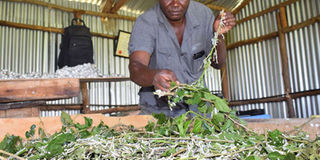Secrets of rearing silkworms for higher profits

Newton Owino in his silkworm farm in Kisumu. He rears the Bombyx mori species of silkworm, which has been domesticated in China for ages. PHOTO | ELIZABETH OJINA | NMG
What you need to know:
- Buy certified seeds to meet the market quality and get high returns.
- Chances of farmers producing poor quality silk yarn is higher when they produce their own eggs.
- Silkworms go through four stages of development. The feeding programme depends on the instar. The young worms should be fed young tender mulberry leaves.
- To manage pests and diseases, farmers need to disinfect the beds prior to hatching and after hatching.
Newton Owino carries a sack full of mulberry leaves and puts it in an iron sheet structure before going for another.
Looking at the structure in Mamboleo in Kisumu, one may think that he is storing animal fodder, until they enter the structure.
But the structure is Owino’s farm, where the sericulture farmer keeps silkworms for the production of quality silk.
Inside the room there are two raised wooden beds where he has placed the silkworms. They are feeding on mulberry when we pop in.
“I rear the Bombyx mori species of silkworm, which has been domesticated in China for ages. The larvae are at their fifth instar, and in matter of days they shall start spinning into cocoons,” says Owino.
The former senior researcher at International Centre of Insect Physiology and Ecology (Icipe) started the silkworm venture in May 2015.
“I was a researcher at Icipe for 14 years. With that knowledge of insect rearing, I developed passion to start my own farm,” says Owino who started with a capital of Sh3,000.
After quitting Icipe, he started by planting the mulberry plants, the first step in setting up a sericulture farm. Today, he has 500,000 mulberry plants on five acres.
To propagate mulberry, one plants cuttings on a well-prepared land. The plants germinate in two to three weeks and one starts pruning in four months to feed the silkworms.
Owino, 39, gets the Bombyx mori silkworm eggs from National Sericulture Research Centre (NSRC) in Thika.
“The eggs come stuck by glue on a paper. We hatch them and start the rearing process,” he says.
The rearing starts with incubation of eggs. For healthy development and uniform hatching, the eggs are incubated under optimum temperatures of 250C and humidity of 80-85 per cent. They hatch in 10-12 days.
“I used to produce my own eggs, unfortunately the extreme weather in Kisumu interfered with the hatching of eggs,” says the farmer.
NSRC director Muo Kasina says chances of farmers producing poor quality silk yarn is higher when they produce their own eggs.
“The Bombyx mori silkworms is a very sensitive insect. Again the dangers of doing your own egg production may lead to the spread of diseases in silkworm,” says Dr Kasina.
POTENTIAL IN SERICULTURE
Silkworms go through four stages of development. The feeding programme depends on the instar. The young worms should be fed young tender mulberry leaves.
The caterpillar eats for 26 days before spinning silk. It takes about three days to fully spin a cocoon and turn into pupa.
“The caterpillar goes into stages until it reaches the fifth instar before it spins the cocoon. Our goal is to harvest the silk cocoon, therefore, we must dry them to avoid the development of pupa into adult, which will break silk yarn,” he explains.
To get good yield, Owino says the caterpillars need to be fed at least four times daily. For sustainability, it is important to have a plantation of mulberry.
“In 26 days, you have quality cocoons, quality yarn and definitely you get good market price,” he says.
Owino works with 37 sericulture farmers from across Kisumu. He supplies the farmers’ larvae at the second instar, when they are actively feeding.
He buys the silkworm cocoons from farmers at Sh2,500 per kilo. He later sells it at Sh4,200 per kilo in US and India, thanks to an official at the Ministry of Industrialisation who linked him to the market. Every month, the farmer collects 100 to 150kg.
“We pack the cocoon in gunny bags before exporting. My target is to supply 1,200kg to the US market and 350kg for the Indian a month.” Sarah Adero is among those who sell the cocoon to Owino. Her farm is in Korowe, Kisumu County.
She harvests 50 to 70kg of silkworm cocoons every month.
“I do the venture as side hustle. In a month, I earn Sh100,000. It is good business considering one gets good returns within a short time,” says Ms Adero.
Owino says production depends on a number of conditions such feeding programme and hygiene standards.
To manage pests and diseases, farmers need to disinfect the beds prior to hatching and after hatching. “We have two major pathogens that affect the Bombyx mori species caterpillar namely nuclear polyhedrosis virus and grasserie. The pathogen chokes the guts of the caterpillar therefore interfering with their feeding habits,” says the farmer.
He advises that fumigates the beds by sprinkling lime on the surface and on the insects.
Despite the huge potential of sericulture, Owino says there are challenges. “Some people think when you keep the worms you are are practising witchcraft.
We must create awareness,” says Owino. He hopes to set up a value addition plant to process silkworm yarn.




